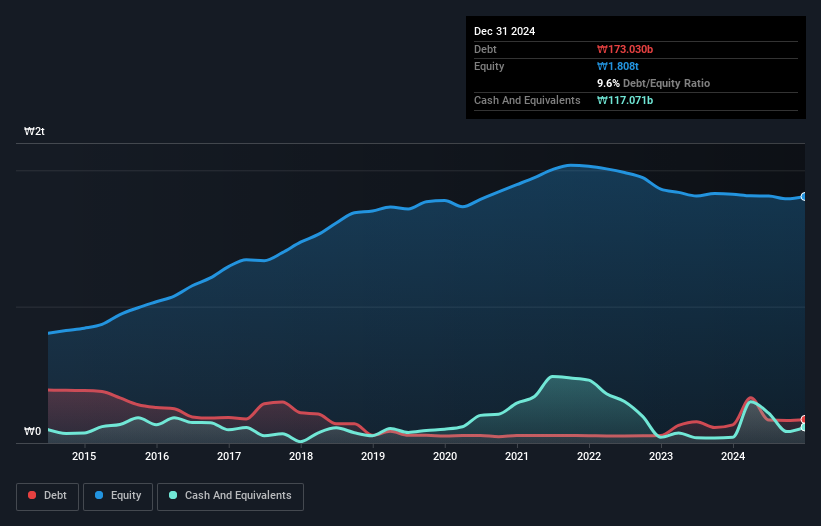Warren Buffett famously said, 'Volatility is far from synonymous with risk.' It's only natural to consider a company's balance sheet when you examine how risky it is, since debt is often involved when a business collapses. We note that Korea Petrochemical Ind. Co., Ltd. (KRX:006650) does have debt on its balance sheet. But should shareholders be worried about its use of debt?
When Is Debt Dangerous?
Debt and other liabilities become risky for a business when it cannot easily fulfill those obligations, either with free cash flow or by raising capital at an attractive price. Ultimately, if the company can't fulfill its legal obligations to repay debt, shareholders could walk away with nothing. However, a more frequent (but still costly) occurrence is where a company must issue shares at bargain-basement prices, permanently diluting shareholders, just to shore up its balance sheet. Of course, debt can be an important tool in businesses, particularly capital heavy businesses. When we think about a company's use of debt, we first look at cash and debt together.
How Much Debt Does Korea Petrochemical Ind Carry?
As you can see below, at the end of December 2024, Korea Petrochemical Ind had ₩173.0b of debt, up from ₩133.4b a year ago. Click the image for more detail. On the flip side, it has ₩117.1b in cash leading to net debt of about ₩56.0b.

How Healthy Is Korea Petrochemical Ind's Balance Sheet?
The latest balance sheet data shows that Korea Petrochemical Ind had liabilities of ₩307.1b due within a year, and liabilities of ₩105.0b falling due after that. On the other hand, it had cash of ₩117.1b and ₩236.5b worth of receivables due within a year. So its liabilities total ₩58.5b more than the combination of its cash and short-term receivables.
Of course, Korea Petrochemical Ind has a market capitalization of ₩540.4b, so these liabilities are probably manageable. But there are sufficient liabilities that we would certainly recommend shareholders continue to monitor the balance sheet, going forward. When analysing debt levels, the balance sheet is the obvious place to start. But it is future earnings, more than anything, that will determine Korea Petrochemical Ind's ability to maintain a healthy balance sheet going forward. So if you're focused on the future you can check out this free report showing analyst profit forecasts .
Check out our latest analysis for Korea Petrochemical Ind
In the last year Korea Petrochemical Ind wasn't profitable at an EBIT level, but managed to grow its revenue by 12%, to ₩2.8t. That rate of growth is a bit slow for our taste, but it takes all types to make a world.
Caveat Emptor
Over the last twelve months Korea Petrochemical Ind produced an earnings before interest and tax (EBIT) loss. Indeed, it lost a very considerable ₩60b at the EBIT level. Considering that alongside the liabilities mentioned above does not give us much confidence that company should be using so much debt. Quite frankly we think the balance sheet is far from match-fit, although it could be improved with time. For example, we would not want to see a repeat of last year's loss of ₩8.5b. In the meantime, we consider the stock very risky. When we look at a riskier company, we like to check how their profits (or losses) are trending over time. Today, we're providing readers this interactive graph showing how Korea Petrochemical Ind's profit, revenue, and operating cashflow have changed over the last few years .
Of course, if you're the type of investor who prefers buying stocks without the burden of debt, then don't hesitate to discover our exclusive list of net cash growth stocks, today.
Valuation is complex, but we're here to simplify it.
Discover if Korea Petrochemical Ind might be undervalued or overvalued with our detailed analysis, featuring fair value estimates, potential risks, dividends, insider trades, and its financial condition.
Access Free AnalysisHave feedback on this article? Concerned about the content? Get in touch with us directly. Alternatively, email editorial-team (at) simplywallst.com.
This article by Simply Wall St is general in nature. We provide commentary based on historical data and analyst forecasts only using an unbiased methodology and our articles are not intended to be financial advice. It does not constitute a recommendation to buy or sell any stock, and does not take account of your objectives, or your financial situation. We aim to bring you long-term focused analysis driven by fundamental data. Note that our analysis may not factor in the latest price-sensitive company announcements or qualitative material. Simply Wall St has no position in any stocks mentioned.
About KOSE:A006650
Korea Petrochemical Ind
Engages in the production and supply of petrochemicals in Korea and internationally.
Undervalued with excellent balance sheet.
Similar Companies
Market Insights
Community Narratives


Recently Updated Narratives

Proximus: The State-Backed Backup Plan with 7% Gross Yield and 15% Currency Upside.

CEO: We are winners in the long term in the AI world

Early mover in a fast growing industry. Likely to experience share price volatility as they scale
Popular Narratives


MicroVision will explode future revenue by 380.37% with a vision towards success


The company that turned a verb into a global necessity and basically runs the modern internet, digital ads, smartphones, maps, and AI.



